Intel's X25-V & Kingston's 30GB SSDNow V Series: Battle of the $125 SSDs
by Anand Lal Shimpi on March 19, 2010 12:00 AM EST- Posted in
- Storage
Overall System Performance using PCMark Vantage
Next up is PCMark Vantage, another system-wide performance suite. For those of you who aren’t familiar with PCMark Vantage, it ends up being the most real-world-like hard drive test I can come up with. It runs things like application launches, file searches, web browsing, contacts searching, video playback, photo editing and other completely mundane but real-world tasks. I’ve described the benchmark in great detail before but if you’d like to read up on what it does in particular, take a look at Futuremark’s whitepaper on the benchmark; it’s not perfect, but it’s good enough to be a member of a comprehensive storage benchmark suite. Any performance impacts here would most likely be reflected in the real world.
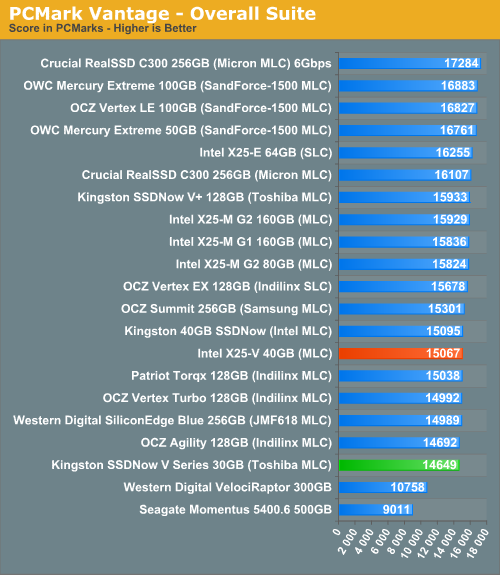
The Intel and Kingston value drives manage to stay close throughout almost all of the PCMark benchmarks. In the Productivity and HDD tests Intel manages to pull ahead by a noticeable margin however.
The memories suite includes a test involving importing pictures into Windows Photo Gallery and editing them, a fairly benign task that easily falls into the category of being very influenced by disk performance.
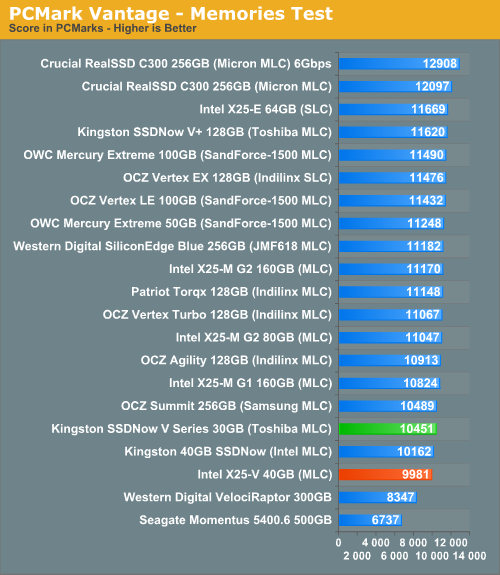
The TV and Movies tests focus on on video transcoding which is mostly CPU bound, but one of the tests involves Windows Media Center which tends to be disk bound.
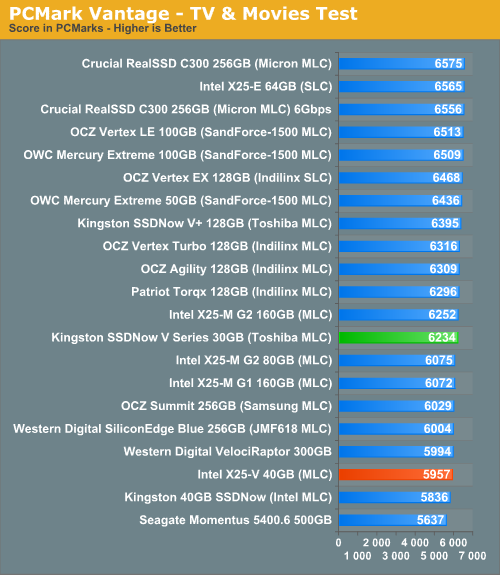
The gaming tests are very well suited to SSDs since they spend a good portion of their time focusing on reading textures and loading level data. All of the SSDs dominate here, but as you'll see later on in my gaming tests the benefits of an SSD really vary depending on the game. Take these results as a best case scenario of what can happen, not the norm.
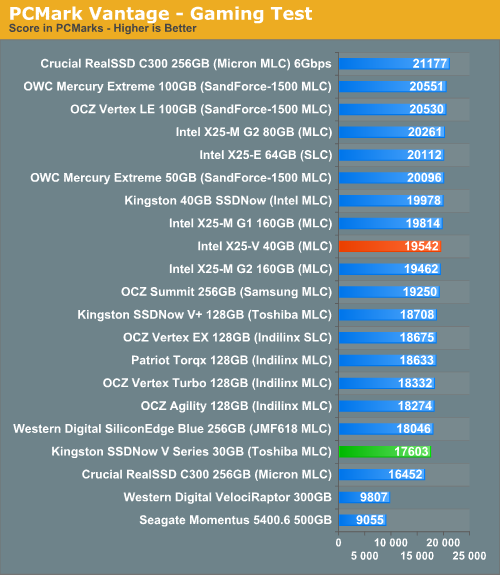
In the Music suite the main test is a multitasking scenario: the test simulates surfing the web in IE7, transcoding an audio file and adding music to Windows Media Player (the most disk intensive portion of the test).
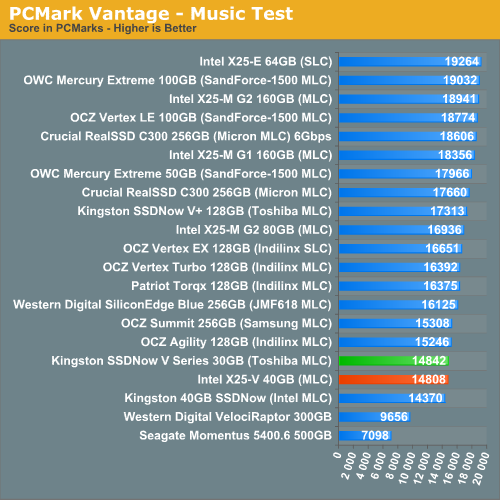
The Communications suite is made up of two tests, both involving light multitasking. The first test simulates data encryption/decryption while running message rules in Windows Mail. The second test simulates web surfing (including opening/closing tabs) in IE7, data decryption and running Windows Defender.
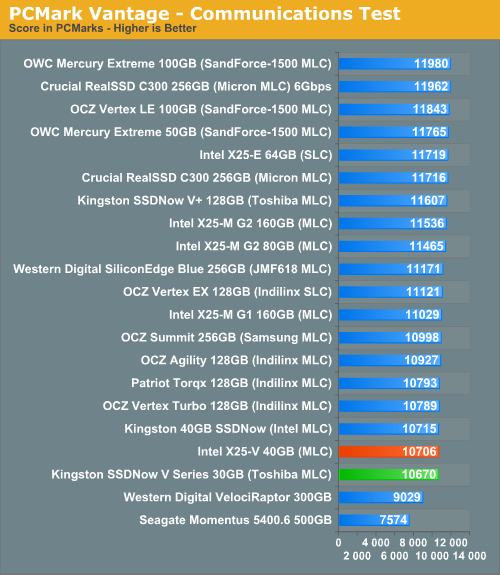
I love PCMark's Productivity test; in this test there are four tasks going on at once, searching through Windows contacts, searching through Windows Mail, browsing multiple webpages in IE7 and loading applications. This is as real world of a scenario as you get and it happens to be representative of one of the most frustrating HDD usage models - trying to do multiple things at once. There's nothing more annoying than trying to launch a simple application while you're doing other things in the background and have the load take forever.
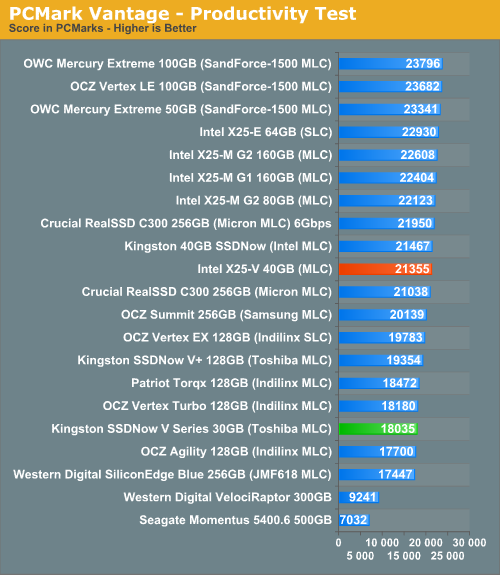
The final PCMark Vantage suite is HDD specific and this is where you'll see the biggest differences between the drives:
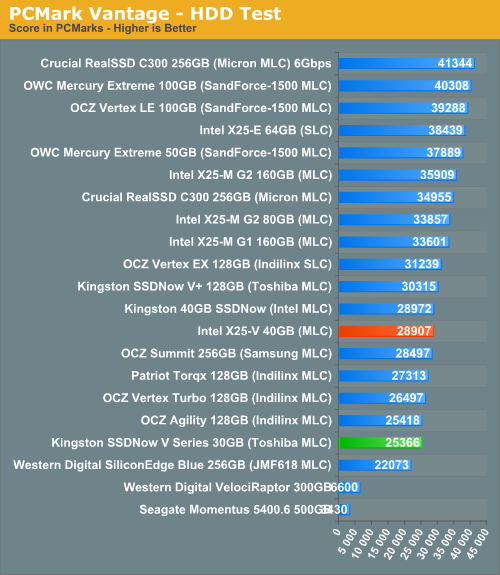










78 Comments
View All Comments
davepermen - Friday, March 19, 2010 - link
technically, still more expensive than the intel 40gb at 125$ (per gb), but yeah, others than just kingston and intel should be listed.still i'm glad for the 33% more storage :)
buzznut - Monday, March 22, 2010 - link
Yeah, this is the decision I made when buying my 40gig. With a win7 install those 10gb make a huge difference. For an entry level SSD, I would recommend the Intel over the OCZ despite some performance differences. Especially when it comes to gaming.Choosing between the Kingston drive and Intel at the time was a no-brainer.
However I would/will look at OCZ vertex series when going to 60GB or higher capacity.
mmntech - Friday, March 19, 2010 - link
It's progress in the right direction though. Wasn't long ago when these small drives were $200-$300. Still, I'm going to wait until 80gb SSDs drop to around that price. More breathing room. Still way too small for laptop use too.vol7ron - Friday, March 19, 2010 - link
I'd like to see the 80GB/160GBs fall in price too. Once they do, I'll consume =]MadMan007 - Friday, March 19, 2010 - link
When you talk about capacities in the chart on page 4 I take it the formatted capacity is in gigabytes (GB) and not gibibytes (GiB). So on top of reserved flash there is also the GB-GiB conversion to account for?gaspard - Friday, March 19, 2010 - link
Harddrives are measured in Gigabytes (1 billion bytes), Operating systems (Windows for example) usually measure in Gibibytes... aka 1024 times 1024 times 1024 = 1,073,741,824 bytesMadMan007 - Friday, March 19, 2010 - link
Thanks bro but that didn't add or clarify anything about my question. The fact that HDs use GB and OSes use GiB was implicit background knowledge for my post. I see Jarrod made a guess but I'd still be interested to know whether the chart on page 4 for formatted capacities especially and others just for funsies is in GB or GiB.JarredWalton - Friday, March 19, 2010 - link
And flash chips are generally measured in GiB as well (or at least, the chips come in powers of 2). I think part of this is SSD makers figure they'll use the GiB vs. GB difference to make up for their spare area. So you can have 7.3% spare area and your 40GiB SSD ends up formatting to the same size as a 40GB HDD. Just a thought.GullLars - Friday, March 19, 2010 - link
This was a good test, and one i've been waiting for a while. I'm a bit disappointed a 32GB Indilinx Barefoot drive wasn't included. I have a 30GB Vertex in my laptop that performs better sequentailly than these numbers, and has better random performance than the Kingston V 30GB. The price is slightly higher though.Ref screenshot: http://www.diskusjon.no/index.php?app=core&mod...">http://www.diskusjon.no/index.php?app=c...h_rel_mo... CDM 3.0 + WEI for my laptop.
Now the next thing I hope Anandtech will do regarding SSDs is a comparison of RAID of low-capasity cheap SSDs VS single high capasity SSDs. This is something no other reckognized tech site has done yet, but enthusiasts have done for years now. Example: http://www.nextlevelhardware.com/storage/battleshi...">http://www.nextlevelhardware.com/storage/battleshi...
I'll also mention Nizzen, an enthusiast on a forum i frequent, who set a WR i PCmark vantage last spring with his 24/7 setup, and is still on top5 with the same setup (updated in august with 4GB RAM on the Areca). The key was an Areca 1680ix-12 with a RAID-0 of several (7 i think) OCZ Vertex.
ORB result page: http://service.futuremark.com/resultComparison.act...">http://service.futuremark.com/resultCom...sultId=2...
24740 PCmarks, WAY ahead of the highest score in your benchmark lists. The same level of disk performance is possible to get with an LSI 9211-8i with 8 30-40GB SSDs in RAID-0 for about $1000 (less than 2 256GB SSDs).
Suggested lineup for such an article: RAID-0 of 4 Kingston V 30GB, Intel x25-V, and Indilinx Barefoot 32GB (Vertex?). 2 RAID-0 SF-1200/1500 50GB, Kingston SSDNow V+ 64GB, Indilinx Barefoot 64GB, Intel x25-M 80GB. And single 100/128/160 GB SSDs of various controllers.
Regarding performance degrading in RAID whitout TRIM, increased reserved area can help negate the performance degrading (Ref IDF whitepaper on spare area). Increasing the spare area to ~20-25% from the default 7% (on most SSDs) will make sure degrading will not be noticable by users in normale usage models.
strikeback03 - Friday, March 19, 2010 - link
So how much faster were program loads and other useful things with that super RAID array?